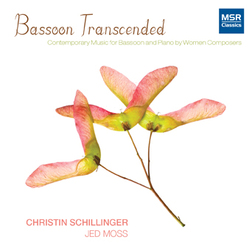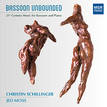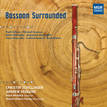CHRISTIN SCHILLINGERAlso Available
 BASSOON TRANSCENDEDContemporary Music for Bassoon and Piano by Women ComposersAdrienne Albert, Elizabeth Alexander, Nancy Galbraith, Susan Kander, Cindy Mctee CHRISTIN SCHILLINGER, bassoon JED MOSS, piano World Premiere Recordings [MS1439] $12.95 LISTEN
REVIEWS
BEST OF 2014David Schwartz, American Record Guide “ ’Nightfall’ brings a restful legato melody for the bassoon that shows Christin Schillininger’s excellent breath control and fine tonal quality… Schillinger and pianist Jed Moss play Circadia with rhythmic alertness and beauty of tone… [Susan Kander’s The Lunch Counter] requires the utmost technique from the bassoonist, but it poses no terrors for Schillinger, who plays her instrument with total mastery... The sound is pristine on this recording and it places the bassoon in front of the piano. Kander’s Lunch Counter alone is so fascinating that it is worth the price of the recording.”Maria Nockin, Fanfare [March/April 2014]“Three years after her first album, “Bassoon Surrounded” (MSR MS1307, Jan/Feb 2010), Christin Schillinger is carrying on her commendable advocacy for new music. Here, homage to women composers yields some very substantial contributions to the catalog of bassoon music. A few of the names, such as Susan Kander and Nancy Galbraith, will ring familiar to some readers; but others, as you will hear if you buy this album, should be more familiar than they are. While the program is interspersed with the novel, humorous, and profound, Dr Schillinger’s style is full of life and inspiration from beginning to end… [the third movement of Elizabeth Alexander’s Fractals] seems to contain the cell of energy that much of her and Jed Moss’s great collaboration springs from… Schillinger plays [the second movement of Adrienne Albert’s Circadia] sonorously with delicate and deliberate lyricism. It seems to exemplify not only her musicianship, but also the mature writing of these lesser-known composers… Schillinger’s vibrant and expressive playing [of the McTee] is complemented by the sturdy, balanced, and sensitive playing of Jed Moss; and at the heart of it is a singular musical spirit driven by musicianship of high caliber… these are the kind of recordings that push the boundaries for so many young bassoonists.… you want to be serious about the bassoon? Well, listen to this.”Schwartz, American Record Guide [January/February 2014]"[Schillinger’s tone is] pure and beautiful”American Record Guide (on Bassoon Surrounded, MS1307)PROGRAM NOTES
LOOKING BACK AND REACHING FORWARDThe Woman Composer and the Contemporary Music Scene The composers featured on this recording represent some of the most exciting musical voices to emerge in the last three decades of American classical music. While limited to literature written for piano and bassoon only for this recording, the music of these composers extends into many different genres and reflects a diversity of compositional approaches. The engagement of these composers with the contemporary concert hall is emblematic of a historical trajectory that frames the very advancement of an American classical aesthetic and extends back to the late nineteenth century. It was during the late 1890s when the female composer emerged out of the private sphere of the home to the public landscape of music composition and music making. This first generation of composers, commonly referred to as “Lady composers,” made significant advancements as related to 1) the type of education offered to female students at universities and seminaries; 2) the amount of access that these women had to aggregations that performed their works; and 3) financial means to insure the publication of their works. This first generation of female composers was associated with the burgeoning concert culture of New England and included Amy Beach, Helen Hopekirk, and Mabel Daniels, all of whom were the first women to write and have their orchestral works performed by major orchestras. The perceived “successes” of this first generation provided a strong foundation on which Mary Howe, Marion Bauer and Florence Price built upon as America transitioned into the first three decades of the 20th century. In the years following World War I, the female composer faced a changing landscape as the advancement of modernism in the form of serialism, machine-influenced music, and expressionism sought to reframe concert music in a masculine aesthetic. The Romantic style, which had dominated much of America’s nationalistic style up until the 1920s, suddenly was rejected and it was believed to be characteristic of the overt “feminization” that had taken place in concert music in the years preceding World War I. Ruth Crawford Seeger was amongst a small group of women composers who excelled in the new compositional approaches that defined modernism. In the years following World War II, women composers battled for relevancy in a rapidly changing environment. Many have benefitted from new opportunities and new definitions of engagement between concert hall and composer that arose in the years following the war. None is more representative of such changes as the expansion of musical culture at U.S. universities and colleges. Many institutions entered a period of growth that included new universities opening and existing ones enlarging their fine arts departments. In-residence and teaching posts emerged that created new opportunities for composers. Also federal, state and local patronage of the arts provided the financial backing for commissions and performances that enabled a number of women composers to achieve certain levels of popularity. Some universities subsidized new music journals and recording companies that documented the contemporary music scene, but many also initiated performance aggregations that have commissioned and debuted new works. The composers represented on this recording represent some of the new emerging compositional voices adding to a growing repertory of bassoon works. While I would be the last to advance the notion that the contemporary music scene is one that is both post-racial and post-gender, I will say that the successful reception of these composers and their works does indicate how far discussions surrounding the role of the woman composer and her place in the concert hall have progressed. As a performer, Christin Schillinger specializes in the accessibility of the avant-garde. Often pairing the neo-romantic with the post-tonal multi-phonic, she teaches from the concert stage and aims to broaden the audience for both new music and bassoon. Bassoon Transcended (2013) and Bassoon Surrounded (2009), both produced for MSR Classics by Swineshead Productions, feature world-premiere recordings of works by living composers. Collaborative composers remark upon her “natural interpretation” and “perfect musical choices.” Schillinger is a frequent performer, lecturer, and guest instructor at universities nationwide. Likewise, she actively participates in the International Double Reed Society, co-hosting the 2012 Conference on the campus of Miami University. Beyond the concert stage, Schillinger researches the historic and current trends in reed-making pedagogy. She believes the enhancement of the student experience creates better discipline, greater understanding, and stronger performance capabilities. Schillinger’s research is soon to be released as a comprehensive text through Indiana University Press. Schillinger received her Doctor of Musical Arts degree from Arizona State University, Master of Music from Michigan State University, and Bachelor of Music in performance and music theory from Northwestern University. Her primary teachers include Dr. Jeffrey Lyman, Albie Micklich, Barrick Stees, Michael Kroth, and Robert Barris. A Fox Performing Artist, she is currently on faculty at Miami University in Ohio. www.schillingerbassoon.com Jed Moss is a high-demand collaborative and concert pianist. Centered in the Salt Lake City region, Moss is the resident pianist for Utah’s elite Ballet West, the Utah Chamber Music Society Series and the Contemporary Music Consortium. Moss collaborates as a symphonic pianist, appearing with festivals across the west including: Teton, Bear Lake, and Deer Valley. As a collaborative chamber musician, Moss appears with musicians from the nation’s top orchestras and universities. He has performed extensively throughout the United States and abroad. Moss is a frequent artist within the double reed genre. In addition to his active collaboration with Dr. Christin Schillinger, he is a member of the Utah-based double reed ensemble, Sundance Trio. He has also twice been a resident pianist for the International Double Reed Society Annual Conferences. Moss has further worked as a studio musician since 1992, recording for motion picture soundtracks at L.A. East studios in Salt Lake City. He has played on several Hallmark Hall of Fame made-for-TV movies as well as Merchant Ivory films. As a recording artist, Moss has collaborated with various instrumentalists as well as vocalists, frequently premiering newly commissioned works. Jed Moss’s flexibility and depth of performance is tribute to his depth of experience. Moss is the former keyboardist for the rock band Air Supply. PROGRAM
ADRIENNE ALBERT (b.1941) CIRCADIA: THREE MOVEMENTS for bassoon and piano Cycles Nightfall Spring Ahead ELIZABETH ALEXANDER (b.1962) FRACTALS for bassoon and piano Cirri Devil’s Staircase Twindragon River Tree Tremas and Squigs CINDY McTEE (b.1953) CIRCLE MUSIC III for bassoon and piano SUSAN KANDER (b.1957) THE LUNCH COUNTER: A MUSICAL PLAY IN SEVEN MOVEMENTS for solo bassoon Jennifer Frank Olivia Margaret Max Specs and Shorty Lorraine NANCY GALBRAITH (b.1951) SONATA for bassoon and piano (Movement I) (Movement II) (Movement III) MSR Classics |


